Geography facts about Americas
Table of Contents
- Countries
- Regions of Americas
- Largest Urban Areas in the Americas
- Funny and oddly named settlements in the Americas
- Climate
- Population
- Population density
- Ancestry
- Native Americans
- Largest Foreign Community in Each Country of Americas
- Languages
- Economy
- Percentage of Total Wealth Owned by the Top 1%
- Human Development Index by Administrative Divisions
- Sport
This post may contain affiliate links. As an Amazon Associate, we earn from qualifying purchases.
The Americas are a landmass in the Western Hemisphere, encompassing North and South America and covering 8% of Earth’s total surface area and 28.4% of its land area.
The name “America” derives from Americus, the Latin version of the Italian explorer who surveyed the new continents, Amerigo Vespucci’s first name. The feminine form of America corresponded with the feminine names of the continents of Europe, Asia, and Africa. North America and South America are typically seen as separate continents and, taken jointly, are called the Americas in the plural, such as the Dakotas or the Carolinas.
Derived from America, the term “American” initially denoted all the Americas. But its usage has changed over time and commonly designates people from the United States. The map below shows a survey on identification with the term “American.”

Countries
There are 35 autonomous states in the Americas. The largest nations by area are Canada with 9,984,670 km² (3,855,103 mi²), the U.S. with 9,833,517 km² (3,796,742 mi²), accompanied by Brazil with 8,515,770 km² (3,287,957 mi²) and Argentina with 2,780,400 km² (1,073,518 mi²). Compared to land area only, the U.S. (9,147,593 km² or 3,531,905 mi²) is the largest country in the Americas, followed by Canada (9,093,507 km² or 3,511,022 mi²). The smallest sovereign nation in the Americas is the island nation of Saint Kitts and Nevis, with 261 km² (101 mi²).

Regions of Americas
There are many ways to split the Americas into regions.

Most of the countries in the Americas are Spanish-speaking countries. Today, 19 out of the 35 nations from the Americas consider Spanish their official language. Therefore, the Americas are commonly divided into two vast cultural regions: Latin America and non-Latin America. Latin America is foremost identified as the cultural region colonized by cultures speaking Latin-based languages like Spanish or Portuguese. But in reality, this division is more complicated.
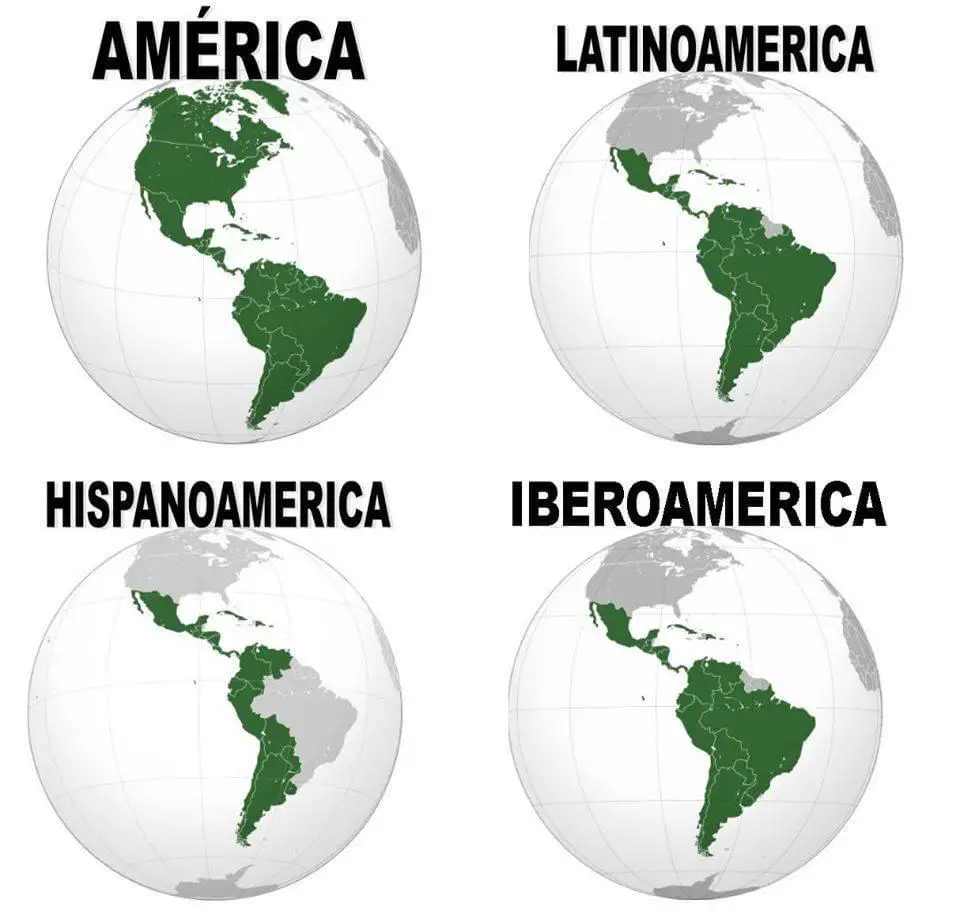
“America” (or the Americas) for the continent(s)
“Latin America” for those places that speak Romance languages (Spanish, Portuguese, French. So yes, it includes Quebec)
“Hispanoamérica” is the area that speaks Spanish (everything but the United States, Brazil, Canada, and French Guiana.
“Iberoamerica” is those areas that were colonized by the Iberia countries (Iberian peninsula), which does not include France.
Largest Urban Areas in the Americas
São Paulo is the most populous city in the Americas, with a metro population of over 22 million people. Below are 15 largest urban areas in the Americas. The less populous among the Americas’ 15 most populous urban areas is Houston. The Metro population of Houston is just over 7 million.
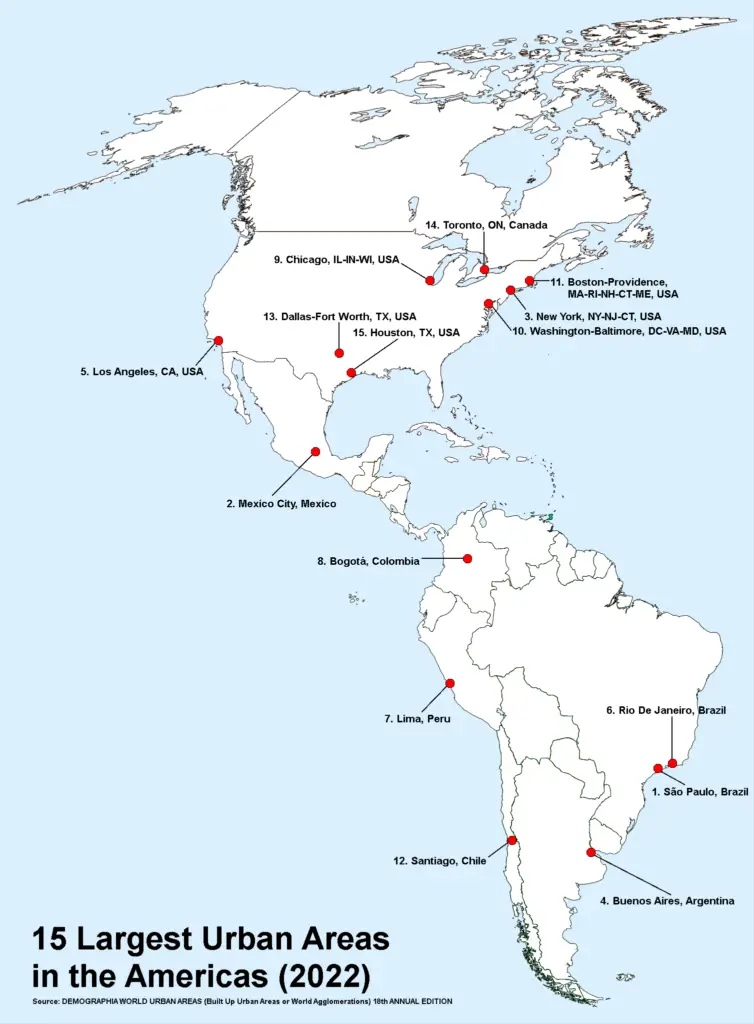
According to Wikipedia, America’s 100 largest cities are home to 78,373,897 people.
Funny and oddly named settlements in the Americas
Everyone knows about cities like New York, Los Angeles, Mexico City, Rio de Janeiro, and Buenos Aires, but some city names are less familiar and harder to imagine.
Discover some of the unique and odd town names found in the Americas.
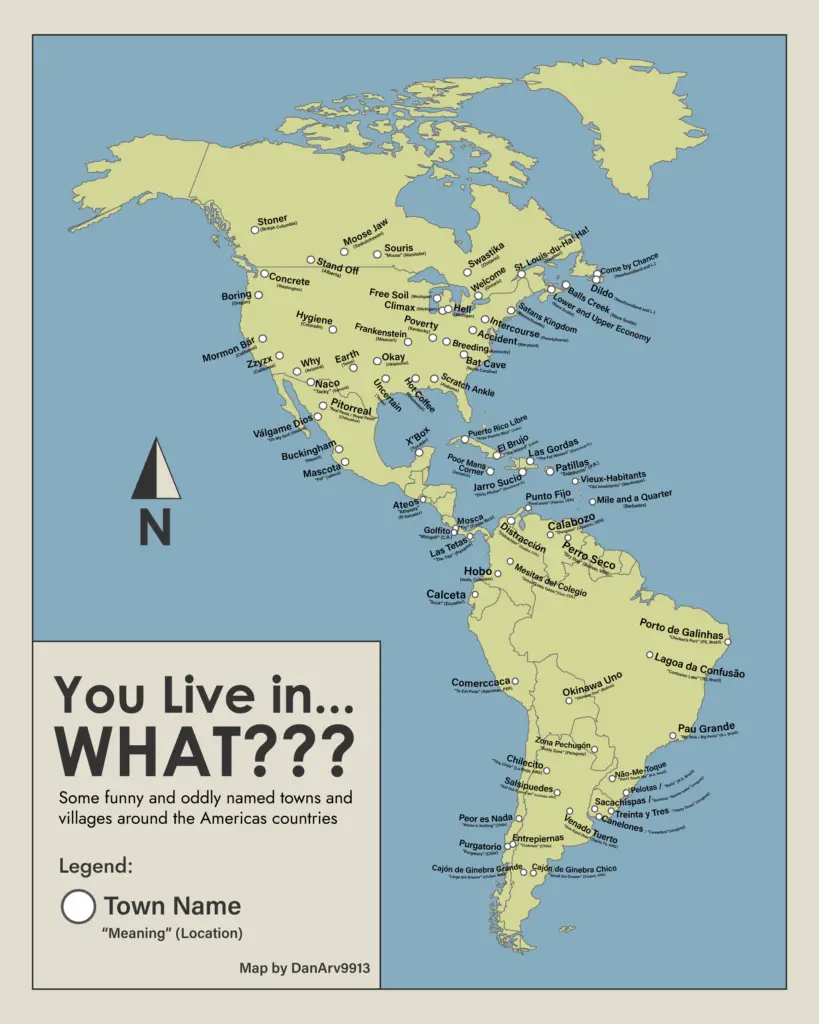
Climate
Since the Americas extend 14 thousand kilometers or 8.7 miles from north to south, the climate varies broadly, from the arctic tundra of Alaska and Northern Canada to the tropical rainforests in Central and South America.
A significant portion of South America, almost all of Central America, and the southern fringe of North America have a tropical climate. The map below compares the latitudes of North and South America.
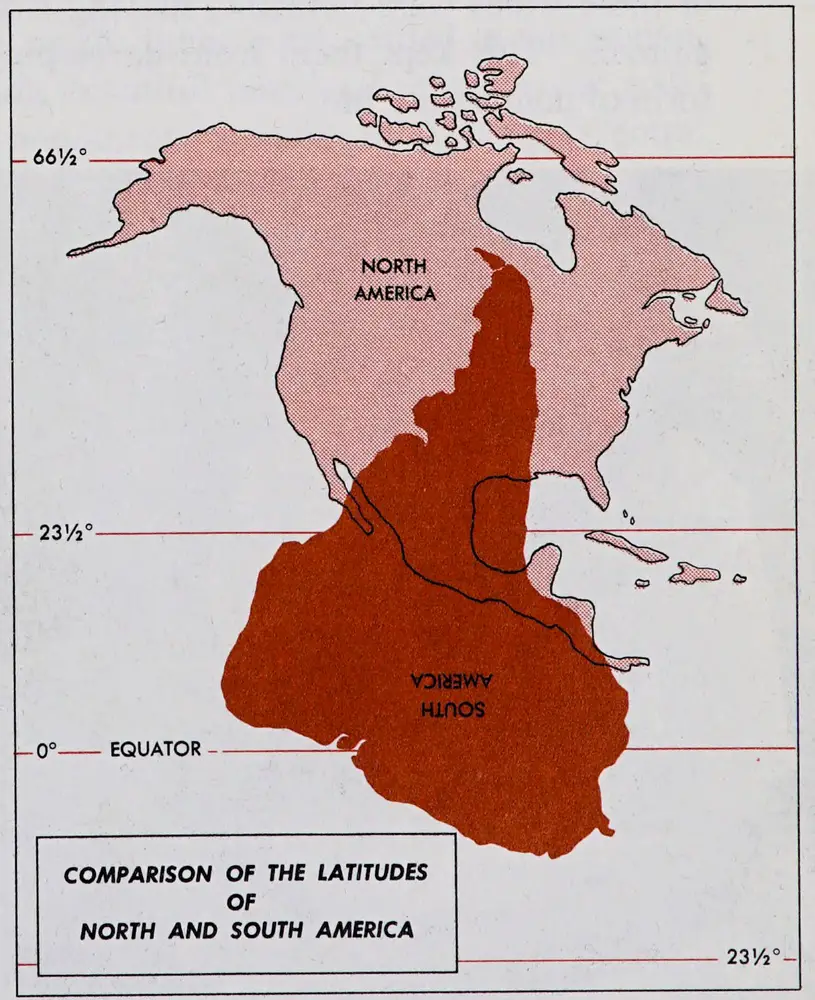
Population
The Americas are home to almost a billion inhabitants (North America is home to about 597 million, while South America has nearly 434 million inhabitants); 2/3 of the Americas’ population live in the U.S., Brazil, and Mexico.
Top 10 countries in the Americas by population
| Country | Population (millions) |
|---|---|
| United States | 335.4 |
| Brazil | 215.9 |
| Mexico | 130.0 |
| Colombia | 52.0 |
| Argentina | 46.2 |
| Canada | 38.4 |
| Peru | 34.0 |
| Venezuela | 28.7 |
| Chile | 19.7 |
| Ecuador | 18.7 |
These top 10 countries also predominantly have the highest population growth.
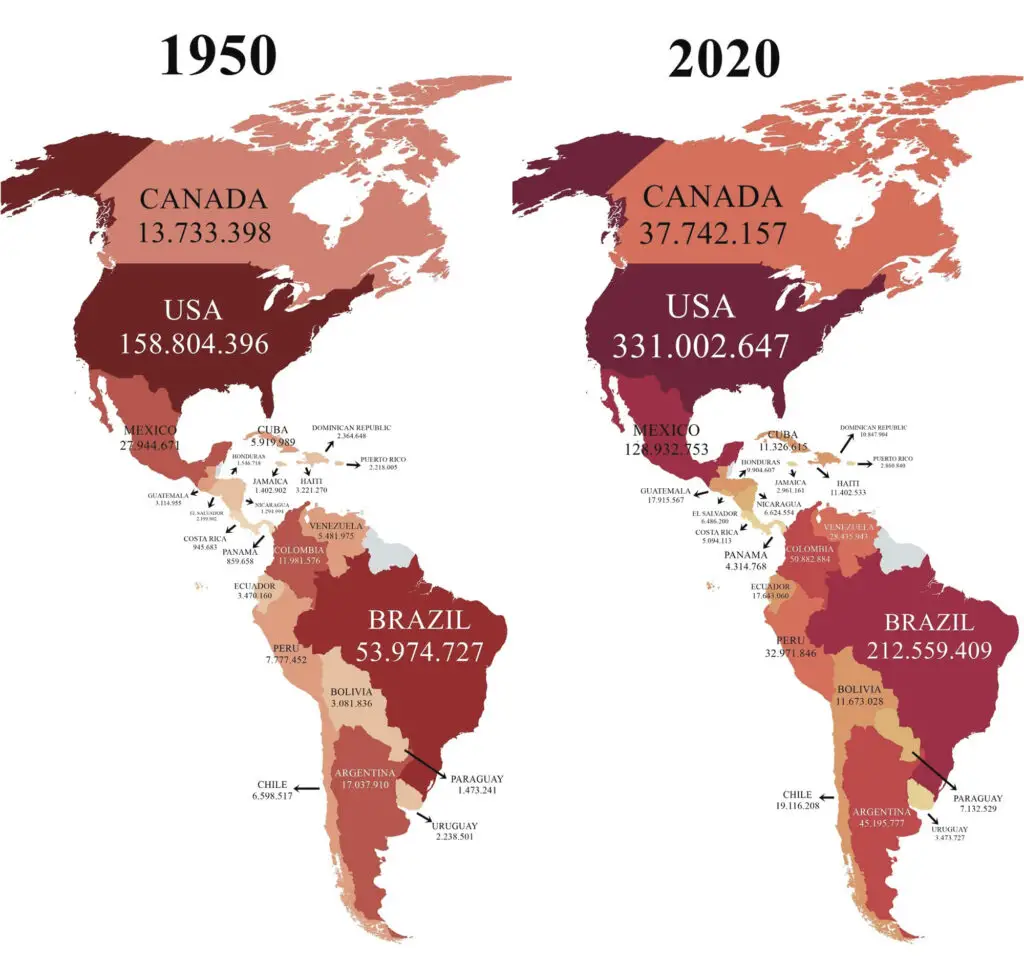
The Americas are home to 8 megacities with over 10 million inhabitants.
| Metropolitan Area | Population (millions) |
|---|---|
| New York City | 23.9 |
| Mexico | 21.2 |
| São Paulo | 21.2 |
| Los Angeles | 18.8 |
| Buenos Aires | 15.6 |
| Rio de Janeiro | 13.0 |
| Bogotá | 10.4 |
| Lima | 10.1 |
Population density
The political subdivisions in which these metropolitan areas are located have the highest population density. The map of the Americas below shows population density of political subdivisions.
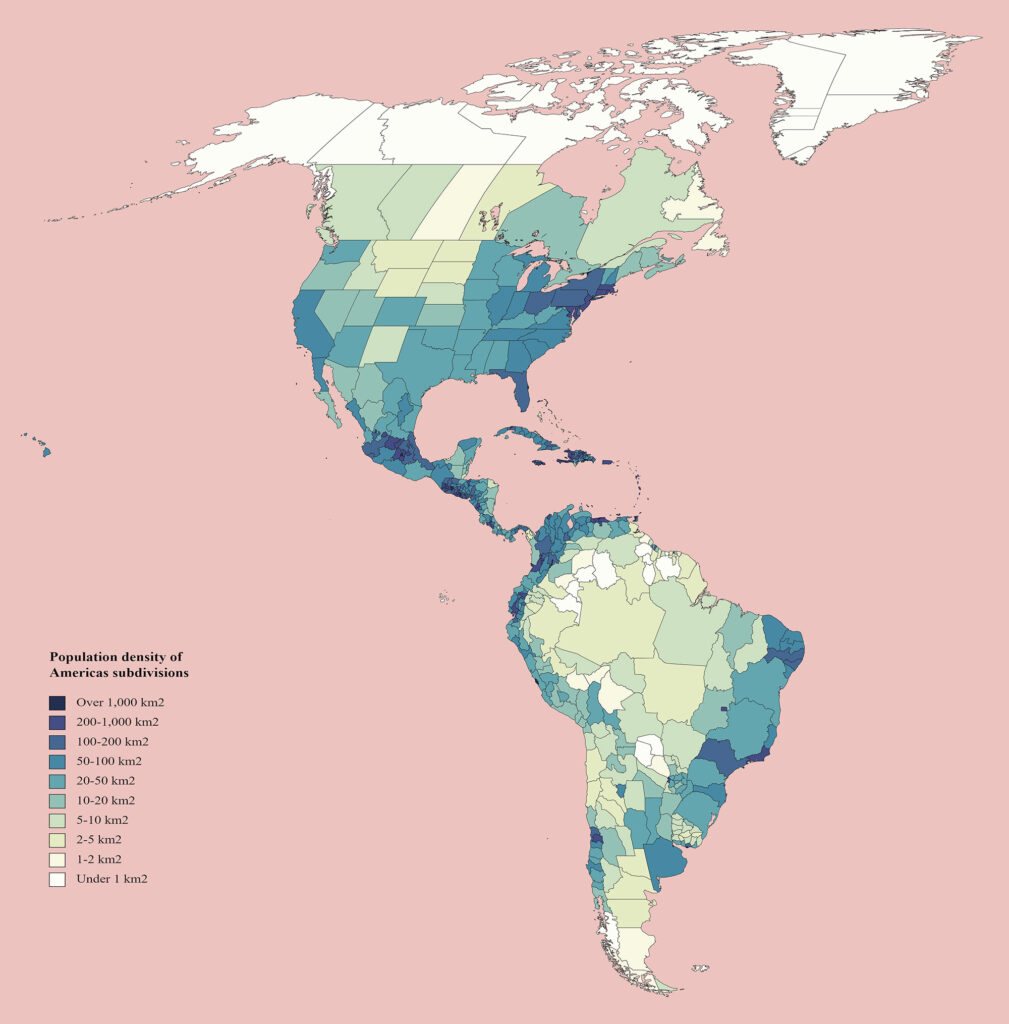
Ancestry
From 1815 to 1932, about 65 million people left Europe in North and South America. These populations also reproduced rapidly in their new habitat. Most European emigrants to the New World came from Germany, Ireland, the United Kingdom, France, Spain, Portugal, the Netherlands, Italy, Norway, Sweden, and Russian Empire. Below is the map of the most common European ancestry in the Americas.
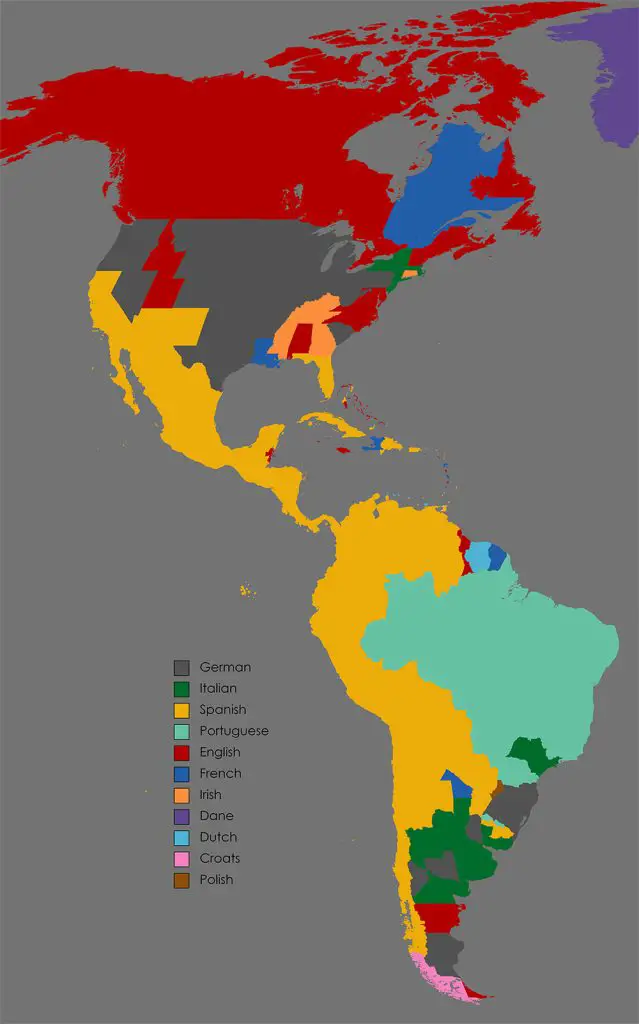
Native Americans
The spatial distribution of Native Americans across the Americas is marked by rich diversity and historical dynamics. In North America, various tribes occupy distinct regions; for instance, the Navajo and Apache are found in the southwestern United States, while the Inuit inhabit Arctic areas. The Great Plains historically hosted nomadic tribes like the Sioux and Cheyenne, relying on buffalo hunting. The Eastern Woodlands, encompassing parts of the eastern United States and Canada, was home to tribes such as the Cherokee and Iroquois. In South America, the Amazon rainforest is home to diverse indigenous groups, facing challenges due to environmental changes. The Andean region boasts a rich indigenous heritage with Quechua and Aymara communities in countries like Peru and Bolivia.
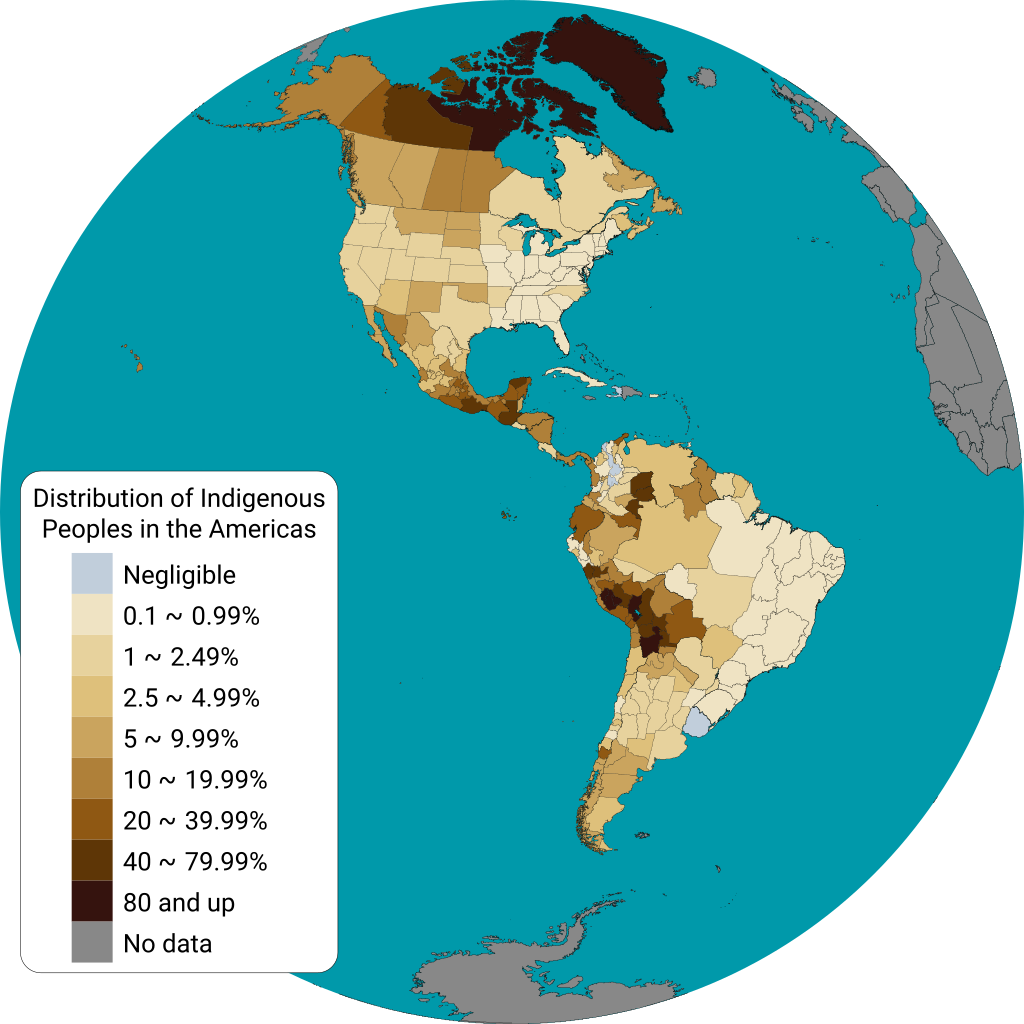
Despite historical disruptions, many Native American communities continue to reside in or near their ancestral lands, emphasizing cultural continuity.
Largest Foreign Community in Each Country of Americas
The Americas exhibit a rich tapestry of diverse cultures, with distinct foreign communities shaping each country’s demographic landscape. In the United States, the largest foreign-born community hails from Mexico, significantly influencing the nation’s immigrant population. Canada boasts a vibrant cultural mosaic, with individuals of Indian origin forming the largest foreign community. However, there has been a notable surge in the emigration of individuals from China to Canada in recent times. Brazil stands out with its substantial Portuguese community. Argentina witnesses a diverse influx of immigrants, with the largest modern foreign community being of Paraguayan and Bolivian descent. In Colombia, Venezuelans constitute the largest foreign group, seeking refuge from political and economic challenges.
The map below created by Reddit user Corleone648 shows the largest foreign community in each country of Americas.
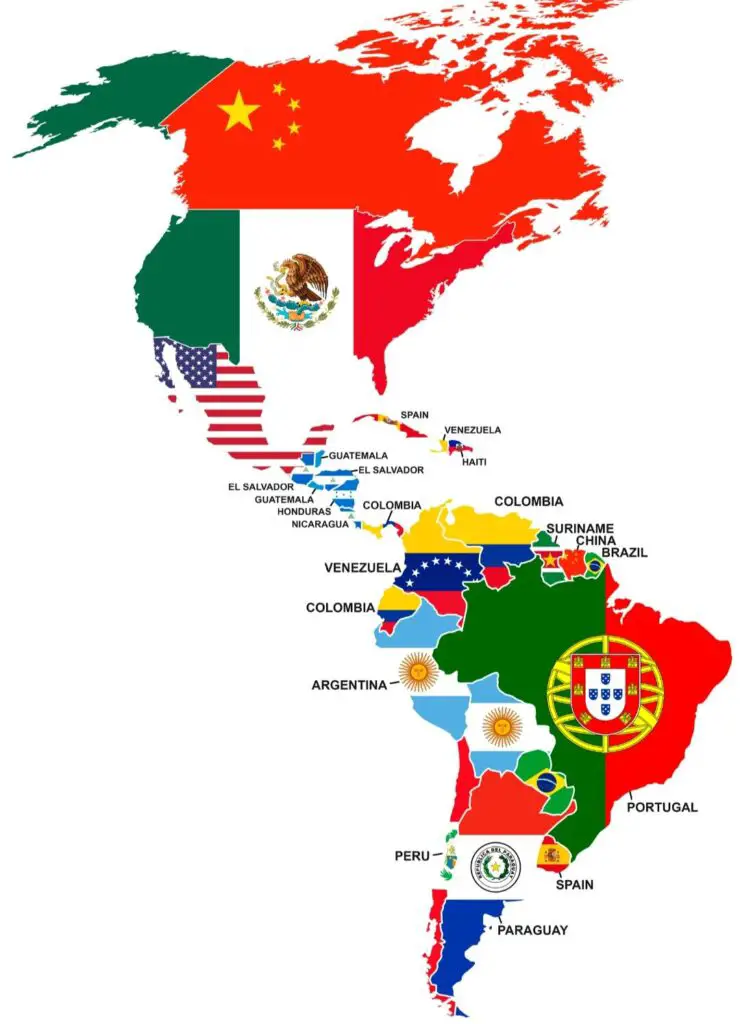
Languages
The most commonly spoken language in the New World is Spanish. The over most spoken languages in this continent are English, Portuguese, and French, as well as indigenous languages Quechua (mainly spoken in the Andes region) and Guaraní.

Most spoken languages in the Americas
| Language | Number of speakers | Spoken in countries |
|---|---|---|
| Spanish | 418 millions | Argentina, Spain, Costa Rica, Bolivia, Cuba, Chile, Colombia, Peru, Ecuador, El Salvador, Equatorial Guinea, Uruguay, Guatemala, Honduras, Mexico, Dominican Republic, Nicaragua, Panama, Paraguay, Peru, United States, Venezuela |
| English | 280 million | Canada, United States, Jamaica, Saint Lucia |
| Portuguese | 209 million | Brazil |
| French | 14 million | Canada, Saint Pierre and Miquelon, Saint Martin, Saint Barthélemy, Martinique, Guadeloupe, , Haiti, French Guiana, the Dominican Republic, Dominica, Grenada, Trinidad and Tobago, United States |
| Quechua | 12 million | Bolivia, Peru, Ecuador, Colombia, Chile, Argentina |
| Guaraní | 5.6 million | Paraguay, Argentina, Bolivia, Brazil |
Economy
The total GDP of the countries in North and South America is $20.971 trillion, but the wealth between the countries in the Americas ranges largely, with considerable wealth inequality within nations. The United States is the largest national economy and leading global trader.
In exports and imports, the U.S. was the world’s second-largest exporter (US$1.64 trillion) and the largest importer (US$2.56 trillion) in 2020. China has recently supplanted the U.S. as a significant trading partner in South America. If in 2000, the principal partner of all North and South American countries for imports and exports was the United States, 21 years later, the situation has changed – in most of South America, including Panama and Cuba, China has taken over the leadership.
The most important partners for the U.S. in the Americas are Mexico, Canada, and Colombia, while for China, the principal partners are Brazil and Argentina.
The map below shows the largest trading partner in the Americas in 2000 vs. 2021.
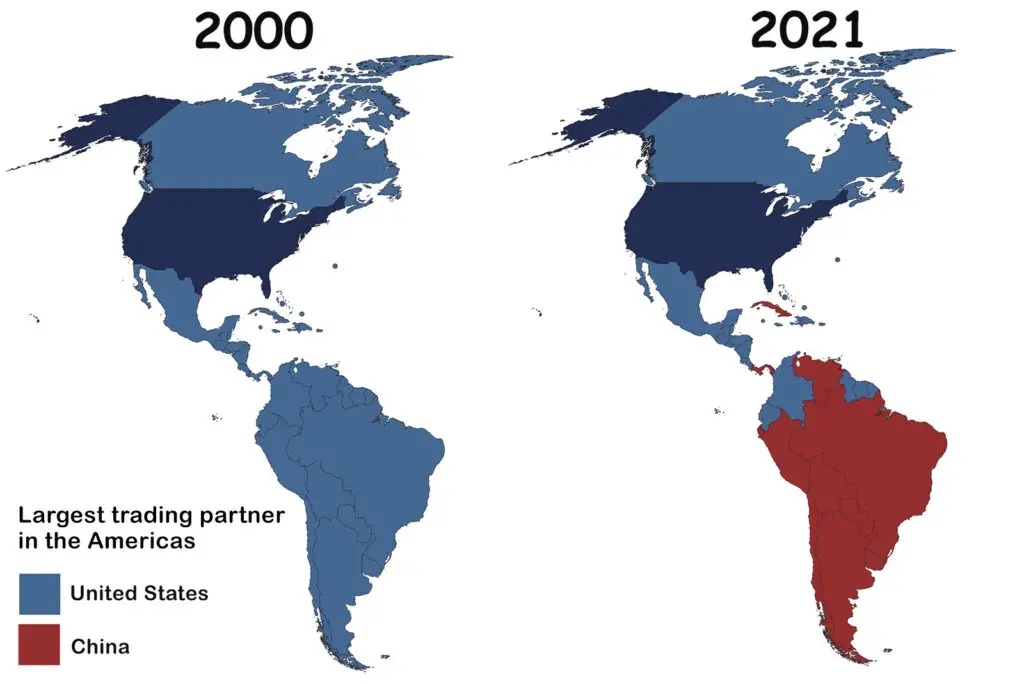
Percentage of Total Wealth Owned by the Top 1%
The map below created by Reddit user Ruben B. Mathisen shows how much wealth is owned by the top 1% of the population.
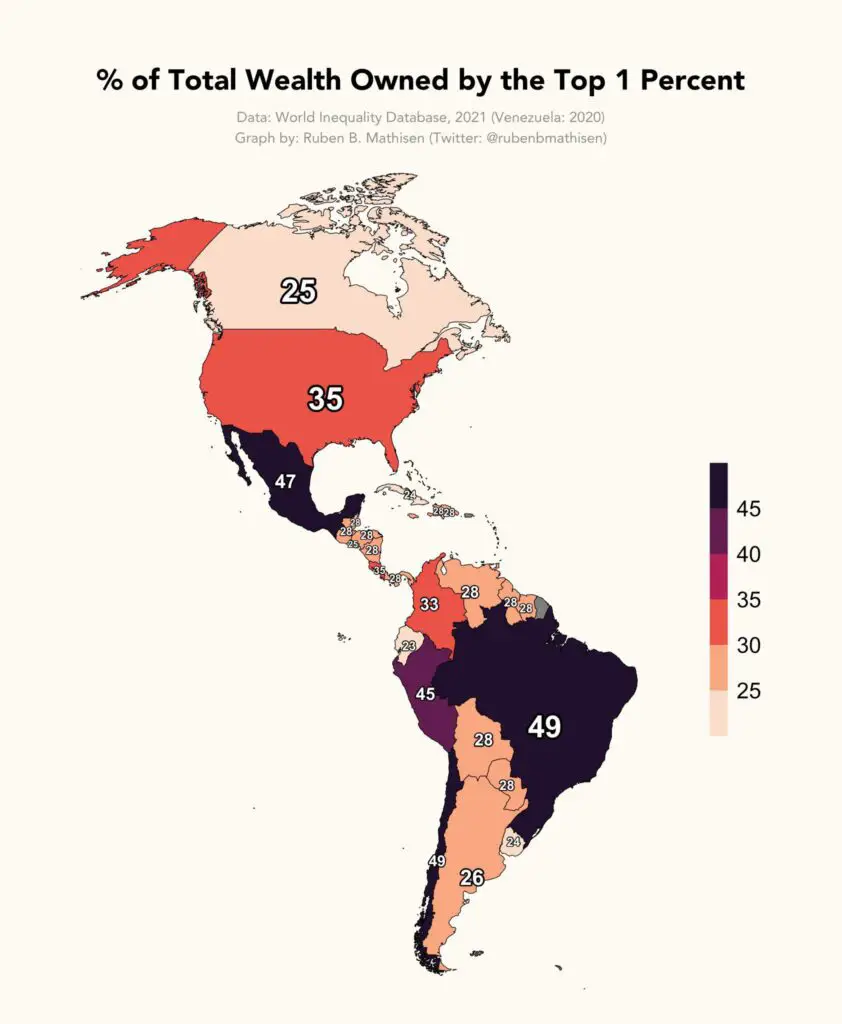
Countries such as Brazil, Chile, Mexico, and Peru exhibit significant wealth inequality, with a prosperous 1% of the population, while the majority experiences comparatively less affluence.
In contrast, nations with lower GDP per capita, including Bolivia, Paraguay, Honduras, Nicaragua, among others, demonstrate a more balanced distribution of wealth.
Conversely, countries like Argentina and Uruguay boast a high GDP per capita alongside a more egalitarian society. These nations are notable for their historically robust middle classes.
The United States displays a pronounced concentration of wealth among the affluent despite its developed status, whereas Canada aligns more closely with the wealth distribution patterns observed in Europe.
Human Development Index by Administrative Divisions
The Human Development Index (HDI) in the Americas varies significantly among countries in the region. Generally, North American countries like the United States and Canada tend to have high HDI scores, reflecting high standards of living, education, and healthcare. In contrast, many countries in Latin America and the Caribbean exhibit a wider range of HDI scores, with some nations achieving high human development levels, such as Chile and Uruguay, while others face challenges related to poverty, inequality, and access to quality education and healthcare, resulting in lower HDI scores. The map below created by Tanatos24 shows the Human Development Index in Americas by administrative divisions.

Sport
In Canada hockey is the most popular sport, in the United States – American soccer. In Latin America, fans prefer soccer the most. The map below created by shows the most popular sports in the Americas.

To learn more about Americas have a look at the following maps:

Abandoned, displaced, and almost empty towns in the Americas.
hola